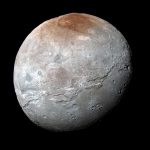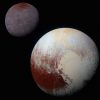50 years ago, astronomers were chipping away at Pluto’s mass0
- From Around the Web, Space
- September 2, 2021
Excerpt from the August 28, 1971 issue of Science News

Excerpt from the August 28, 1971 issue of Science News

Collisions between bodies in our Solar System produce impact craters on large objects at a rate that depends on the population of impacting small bodies. By mapping the scars of ancient impacts on the surfaces of Pluto and its moon Charon, planetary researchers have discovered a surprising lack of very small objects (from 300 feet to 1 mile, or 91 m to 1.6 km, in diameter) in the Kuiper Belt.

The largest of Pluto’s five moons, Charon, was discovered 40 years ago today by James Christy and Robert Harrington at the U.S. Naval Observatory in Flagstaff, Arizona – only about six miles from where Pluto itself was discovered at Lowell Observatory. They weren’t even looking for satellites of Pluto – Christy was trying to refine Pluto’s orbit around the Sun.

Pluto is a very strange world. With satellites like Charon and New Horizons, we have learned a little more about it.

A new model developed by University of Rochester researchers could offer a new explanation as to how cracks on icy moons, such as Pluto’s Charon, formed.



